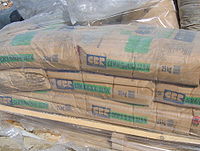
Photo from wikipedia
In this study, the steel manufacturing waste Basic Oxygen Furnace Sludge (BOFS) was tested as permeable reactive material for the remediation of soil contaminated with chromium. The material presents a… Click to show full abstract
In this study, the steel manufacturing waste Basic Oxygen Furnace Sludge (BOFS) was tested as permeable reactive material for the remediation of soil contaminated with chromium. The material presents a high content of elemental iron and iron oxides typical of the steel manufacturing process. Here we propose a scheme of the chemical reactions responsible for remediation process including BOFS dissolution, Cr(VI) reduction and Cr(III) precipitation. Batch reactors showed that Cr(VI) removal increases as the pH decreases. Column tests demonstrated that the simulated PRB with BOFS as the reactive media was quite effective for removing Cr(VI) from groundwater, with a sorption capability of 0.213 mg Cr per gram of BOFS at an initial Cr(VI) concentration of 50 mg L-1 at pH 5.5. A long-term test lasting 71 days confirmed the proposed mechanisms and the suitability of using BOFS in a permeable reactive barrier.
Journal Title: Journal of hazardous materials
Year Published: 2018
Link to full text (if available)
Share on Social Media: Sign Up to like & get
recommendations!